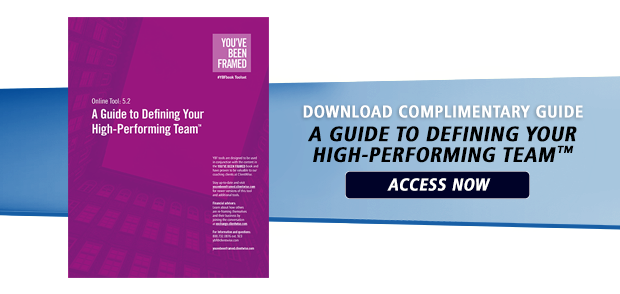How to Operationalize Your Wealth Management Vision
It’s an incontrovertible fact that the majority of wealth management advisors vision statements never effectively drive firm success for the simple reason that they’re never operationalized. The chronic gap between business conversation and business activity renders them essentially nothing more than feel-good wishes until they are truly used to create and implement operational actions.
Many wrestle with the challenge of how to begin turning our ideas into actions. What’s that first step? To design powerful actions that will incorporate and be driven by your measures of future success, you must first be clear about your present.
You must define where you are today, what exists that will support your future vision? What must be changed or newly created to fully attain what you want?
Every strategic decision you make within your business should lead you closer towards realizing your professional and personal purposes (i.e., the satisfaction you derive from your work, and the fulfilling things your work enables you to do in your personal life). Often, the only decision-making criteria and success metrics advisors use are monetary ones (e.g., AUM, revenue, number of clients) which can lead to feeling of hollowness in their work.

Shifting your perspective
Instead of approaching strategic decisions solely from a financial cost/benefit analysis, start looking at them from a personal and team satisfaction cost/benefit perspective. For example, perhaps purely from a revenue standpoint, attracting more of client type A would optimally drive your firm’s profitability. However, you and your team find very little enjoyment or satisfaction in working with those clients and instead would much prefer working with client type B.
Despite the apparent financial incentive to pursue the first course of action, more often than not the personal and professional fulfillment derived from the second path will in the long run yield even greater financial success.
A consistently used decision-making process that heavily factors in personal and professional purpose tends to propel attainment across all domains, both human and financial. Strategic decisions and their attendant actions become more complete and more clearly directed toward envisioned your future success. In addition, the motivational reasons for action become clearer as well.
The result? Better, more thoughtful, more satisfying decisions in all areas of your business, its people, and its future.
Coaching Questions from this article:
-
How do you currently leverage your personal and professional purposes when it comes to making strategic decisions?
-
What additional benefits might you and your business derive from integrating your personal and professional purposes more fully into your strategic decision-making process?
-
What steps can you take to formalize a strategic decision-making process that is more dependent on satisfaction and fulfillment measures than financial metrics?
Topics: Operations


